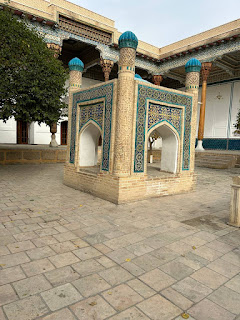Chor Bakr

Chor-Bakr is a memorial complex in the village of Sumitan at 5 km of Bukhara in Uzbekistan, built over the burial place of Abu-Bakr-Said, who died in the year 360 of the Muslim Calendar (970–971 AD), and who was one of the four of Abu-Bakrs (Chor-Bakr) – descendants of Muhammad. The complex includes the necropolis of family tombs, and courtyards enclosed with walls. The Chor Bakr Memorial Complex, also known as Sumitan's cemetery, was established by Shaybanid ruler Abdullaxon II in 1559, and it includes a mausoleum, a mosque, a madrasa, and a large courtyard surrounded by high walls.[2][3] In the following centuries, additional buildings were constructed, and the complex was expanded to include adjacent areas. Abdullaxon II allocated 70,000 gold coins for the construction of this memorial complex.[4] The central building of the complex is the mausoleum, which has doors on all four sides. The mausoleum has a two-story structure with two rooms and a domed chamber on top The mihrab (...





